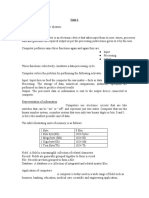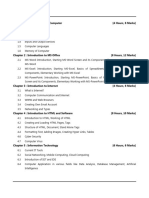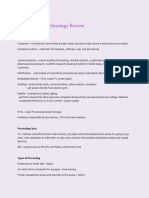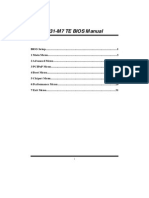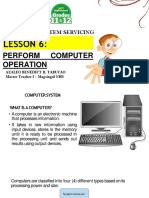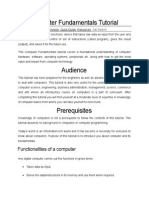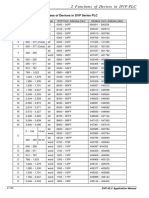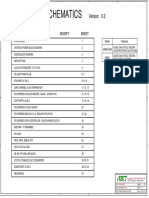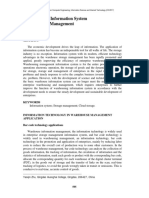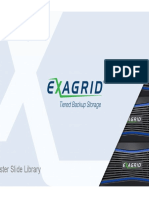Study Material: Introduction to Computers
1. Computer
A computer is an electronic device that can accept data (input), process it using instructions
(programs), store the results, and produce output in a desired format. It works on the principle of
Input → Processing → Output → Storage (IPOS cycle). Computers operate with both hardware
(physical components) and software (programs that give instructions).
2. Characteristics of Computers
Computers have several unique features that distinguish them from humans and other machines: 1.
Speed – Can perform millions of calculations in a fraction of a second. 2. Accuracy – Produces
error-free results if input and program logic are correct. 3. Automation – Once programmed, it
carries out tasks automatically without manual intervention. 4. Versatility – Can perform a wide
range of tasks (scientific, business, multimedia, etc.). 5. Storage Capacity – Can store large
volumes of data and retrieve them quickly. 6. Connectivity – Can connect to networks and share
information. 7. Diligence – Unlike humans, computers don’t suffer from fatigue or boredom; they
can work continuously. 8. Multitasking – Capable of handling multiple jobs simultaneously.
3. History of Computers
The history of computers is usually divided into generations based on technology used: -
Pre-computer Era (Before 1940s): Abacus (3000 BC), Pascaline (1642), Analytical Engine (1837 by
Charles Babbage), Ada Lovelace (first programmer). - First Generation (1940–1956): Vacuum
tubes, large size, high electricity consumption. Examples: ENIAC, UNIVAC. - Second Generation
(1956–1963): Transistors replaced vacuum tubes. Examples: IBM 1401, IBM 7090. - Third
Generation (1964–1971): Integrated Circuits (ICs). Examples: IBM 360 series, PDP-8. - Fourth
Generation (1971–1980s): Microprocessors introduced. Personal computers developed (Apple II,
IBM PC). - Fifth Generation (1980s–Present): Based on Artificial Intelligence, VLSI, ULSI chips.
High-speed networks, laptops, smartphones, IoT.
4. Classification of Computers
Computers can be classified in different ways: (a) By Purpose - General-purpose: Can perform
various tasks (PCs, laptops). - Special-purpose: Designed for a specific application (embedded
systems). (b) By Size and Capacity - Supercomputers: Extremely powerful, used in weather
forecasting, defense, space research. - Mainframe Computers: Large, high-speed, handle
thousands of users simultaneously. - Minicomputers: Mid-sized, used in medium businesses. -
Microcomputers (Personal Computers): Laptops, desktops, tablets. (c) By Data Handling - Analog
Computers: Handle continuous data (engineering, scientific applications). - Digital Computers:
Handle discrete binary data (0s & 1s). - Hybrid Computers: Combine features of both analog &
digital.
5. Applications of Computers
�Computers are applied in almost every field of life: - Education: e-learning, online exams, virtual
classrooms. - Business & Commerce: Accounting, e-commerce, payroll, marketing. - Science &
Engineering: Research, simulation, design (CAD/CAM). - Medicine & Healthcare: Diagnosis, patient
records, medical imaging, robotic surgery. - Government: e-Governance, defense, public services. -
Communication: Email, video conferencing, social media. - Entertainment: Movies, music,
animation, gaming. - Banking & Finance: Online banking, ATMs, stock trading.
6. Basic Organization of a Computer
The basic functional units of a computer system are: 1. Input Unit: Accepts raw data and
instructions (keyboard, mouse, scanner). 2. Central Processing Unit (CPU): Brain of the computer,
consisting of: - Control Unit (CU): Directs data and instruction flow. - Arithmetic Logic Unit (ALU):
Performs arithmetic and logic operations. - Registers: Small, high-speed storage inside CPU. 3.
Memory/Storage Unit: - Primary: RAM (temporary), ROM (permanent). - Secondary: Hard disk,
SSD, CDs. 4. Output Unit: Displays results (monitor, printer, speakers). Diagram (simplified): Input
→ [CPU: CU + ALU + Registers] ↔ Memory → Output



















